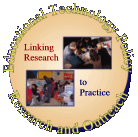Follow-up Homework/Read
Introduction: Why technology? Policies that Drive New Directions
We have spent time exploring business and "society's" input on digital literacy which has helped direct the push on standards (technology and content areas). Next, we will explore the role that politics has on implementation of initiatives that filter down into the individual classroom.
Today's educational arena is driven mainly through the 2001 No Child Left Behind Act (NCLB is revised version of the earlier Elementary and Secondary Education Act of 1965, which originated during Lyndon B. Johnson's term, coined " War on Poverty". Administrations over the years have revamped (marked) the Act. The forward roll of technology in classrooms, every classroom wired with Internet access and the focus on narrowing the "digital divide" has slowed to a snails pace-as the new agenda calls for standards, standards based assessments, standardized curriculum, testing in reading and math and science (kicks in this year)-with a small mention of technology via the statements, "… goal of this part is to improve student academic achievement through the use of technology in elementary schools and secondary schools.(2) ADDITIONAL GOALS- The additional goals of this part are the following:(A) To assist every student in crossing the digital divide by ensuring that every student is technologically literate by the time the student finishes the eighth grade, regardless of the student's race, ethnicity, gender, family income, geographic location, or disability. While there has been a push to utilize technology to help with tutoring, to supplement reading programs, and to help special needs students (assistive technology) the bulk of the funding has been allocated to local school systems to support their mandated data management systems and Professional development has focused on data collection and assessment strategies via technology.
This session's readings will begin by providing background information on ESEA and will then allow you to delve deeper into the impact of NCLB. You will then grab a snapshot of how some educational technology advocates are arguing for more support for technology lobbying that stipulations via NCLB are being met with the aid of technology.
Readings:
Start by reading several background briefings related to the earlier Elementary and Secondary Education Act
- Wikepedia's short overview
- Historical Context of ESEA (1965)
- Policy and Equity Briefing [Word ... PDF] here is a brief introduction to an earlier paper I wrote investigating the question, "Do Federal Funded Programs Make a Difference on Closing the Achievement Gap?" via statistical analysis of data from the NELS dataset
Next, read about the impacts from NCLB and the current state of affairs
by reading Edweek.org's Technology Counts Yearly Report
- How Graded the States [PDF]
- Tracking US [PDF]
- Sources and Notes [PDF]
- About the EPE Research Center's Annual State [PDF]
- DC STR2007 [PDF]
- NCLB in full (in case you are interested)
You may have found that the information from this session has captured your attention and would like to read further. Here are additional resources
- AERA Closing the Gap: High Achievement for Students of Color. Fall 2004, Volume 2 Issue 3. [PDF]
- AERA Teachers Matter: Evidence From Value Added Assessments. [PDF]
- Brown, J. S., (2002). Growing Up Digital: How the Web Changes Work, Education, and the Ways People Learn. United States Distance Learning Association. Retrieved on December 10, 2004, from http://www.usdla.org/html/journal/FEB02_Issue/article01.html
- Wiley, D. A and Edwards, E. K. (2002). Online self-organizing social systems: The decentralized future of online learning. Retrieved December 10, 2004 from http://wiley.ed.usu.edu/docs/ososs.pdf [PDF]
- Skim: Critical Issue: Using Technology to Enhance Engaged Learning for At-Risk Students
- Skim: Critical Issue: Using Technology to Improve Student Achievement
- How can technology enhance student learning? (short article)
- Explore: New Horizons for Learning: Technology in Education
- Learning for the Future: Changing the Culture of Math and Science Education to Ensure a Competitive Workforce.
- Tech funds essential to NCLB
- A Nation Online: Entering the Broadband Age
- FALLING THROUGH THE NET: TOWARD DIGITAL INCLUSION
- Falling Through the Net II: New Data on the Digital Divide
Follow-up Homework/Activities
- Complete the Teacher Technology Profile Matrix for yourself [Word]
- Brainstorm and send along via email dpruitt@umd.edu [Word ... PDF]
|




















